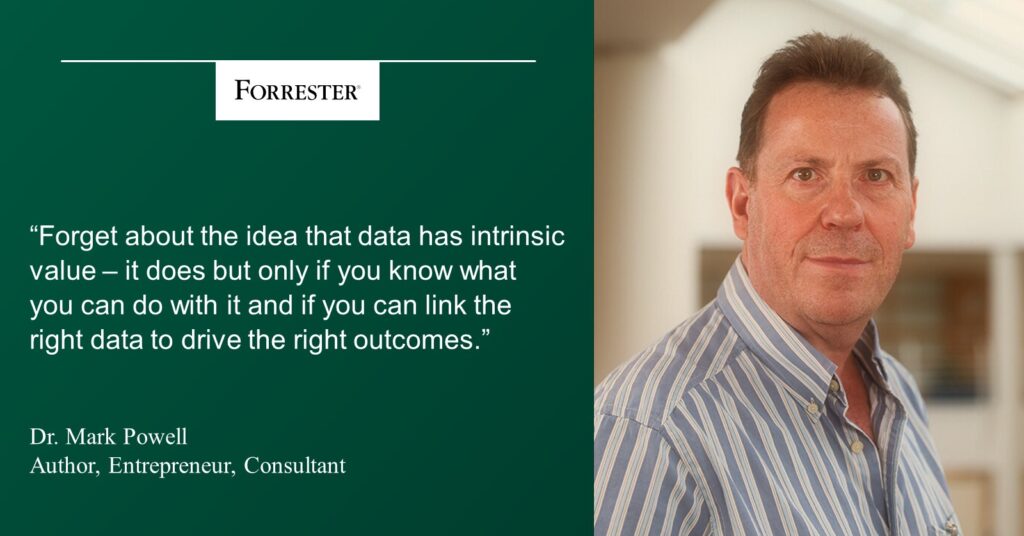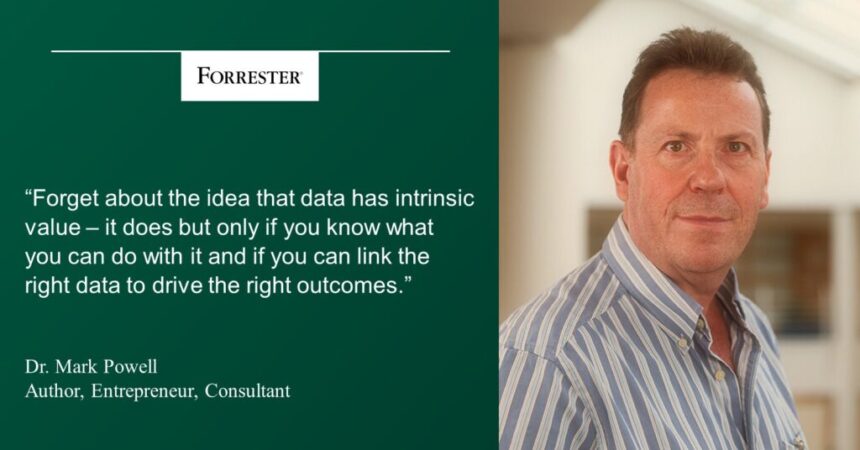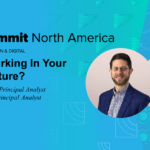Data-driven insight is the key to unlocking reliable value generation with business transformation. In the recently published book, The Fifth Phase, An Insight Driven Approach To Business Transformation, author, consultant and entrepreneur Dr. Mark Powell, outlines the steps that organizations can take to reduce risk and increase value delivery with a rigorous and outcomes-focused approach towards data-driven insight.
I recently spoke with Mark to discuss his work on insight-driven transformation, the success factors he has identified and how companies can transition towards the next phase of digital transformation.
Manuel: Mark. Thank you very much for being with us today and sharing your thoughts on insight-driven transformation. Your recent book on the subject is titled “The Fifth Phase”. What inspired you to write this book and what’s your key message to readers?
Mark: Frustration! That was my inspiration. For the past eleven years I have been working with organizations on what I think of as “art of the possible” in terms of what is possible to drive transformational change from the application of data, analytics, and AI. So many times, I have been involved in projects which were able to transform organizations, or at least part of them, and so many times I watched while the potential was not delivered due to a range of cultural, organizational and mindset issues. I realized that data, analytics, and AI was largely seen as technology (and thus as a tool) rather than as a way to potentially completely re-imagine how things were done. I realized that AI and all the associated technology needed to be embraced as the next level in business transformation if we were to exploit the potential it holds.
The Fifth Phase Of Business Transformation
Manuel: Can you elaborate on why Fifth Phase is fundamentally different compared to the prior approaches towards business transformation? And why is now the time for organizations to embark on it?
Mark: If you look at the evolution of business transformation since Frederick Taylor, it is clear that all approaches have been fundamentally around the concept of efficiency in terms of process improvement, one way or the other. It does not matter if you are talking about time and motion, ERP or Lean, they are all about reducing waste from the system, whatever that system is. It’s not a surprise, the easiest and fastest way to improve profitability and shareholder value is to reduce costs. The Fifth Phase, while also potentially having cost reduction elements to it, is about re-imagining business models from the perspective of new insights. What if we knew things that we previously did not know? How would that affect not just driving efficiency but actually changing processes, structures, functions and the very way we actually run our businesses. The time is now, because data, analytics and AI is now at the point where it can enable re-imagination in ways that simply were not possible even a few years ago. The time is now, because we live in a world where if you don’t re-imagine your business and your business model others will do it for you. The time is now, because the world needs to drive even greater productivity and growth if we are to meet the growing demands on resources with which we are faced.
Manuel: Could you share one of the case studies presented in your book that emphasizes the value of this insights-driven approach?
Mark: Water leakage. Now that sounds exciting. I have spent most of my career in the energy, utilities, and infrastructure sectors. My journey started in the water sector. I had run out of new ways to drive transformation and was looking for new ideas. The company I worked for at the time had nothing to offer, but had a small, and very capable data science team. When I looked at some of the things they were doing around pricing optimization in retail I realized that we might be able to use the same capability to drive change in the water sector. I had an old friend and client who was a CFO of a water company and was open to exploring new ideas. We spent 2 days with the whole board re-imagining the company as a series of analytics questions rather than as a group of functions and silos. One of the largest issues in the water industry is the fact that about one third of all water leaks into the ground. The cost of this is enormous in terms of cost of treatment (and power consumption), as well as the costs of fixing the leaks. So, the question was, could you identify and locate leaks on an underground network just by applying machine learning. Turns out that you can. We were able to prove that you could reduce the time it takes to identify and locate a leak from 6-8 weeks to 2-4 weeks. This is huge, this is transformational. But……. I was involved in building the same solution 4 times and not once did the organization actually implement the solution fully due to various cultural, mindset and functional issues including union resistance. That solution, if delivered across the whole industry could have driven multiple billions in value for shareholders and lower costs and better services for customers but never fully happened. Interestingly, one of the senior executives I built the solution for was fired ……. for not hitting the leakage target!
Manuel: Thank you for sharing this intriguing example. Do you have any advice for organizations about how to start this transition? How can leaders establish the necessary enablers, reduce the related complexity, start small, and showcase the value of this data-driven approach?
Mark: I have a few bits of advice. Firstly, you have to change the mindset and see AI and analytics as the basis for the next stage of business transformation. You have to move away from the idea that data and the associated technology is “tech”, yes, it is but it is not a service to the business, and it’s not an end in itself, it’s the basis for re-imagining what the organization might be in the future. Senior business executives do not need to know how to code, but they do need a better understanding on how AI might be deployed. Equally, the IT and tech side of the business needs to be much closer to the business and strategic decision-making process. If you look at the Boards of the largest organizations in the world, you will find very few (VERY FEW!) CEO’s who used to be CIO’s, CTO’s or CDO’s. This needs to change. Equally, you need to be much more prepared to break down traditional silos and functions to enable the kind of transformations that analytics and AI could enable. This will take courage and a willingness to take some risks.
Manuel: Once the first steps have been taken, what are the ongoing risks and challenges when adopting this approach? Can you share some of your insight on the success factors that are necessary to drive insight-driven business transformation across an enterprise?
Mark: Never underestimate the inability of an organization to not be able or prepared to change. Machiavelli was not wrong when he wrote in The Prince – “There is nothing more difficult to take in hand, more perilous to conduct, or more uncertain in its success, than to take the lead in the introduction of a new order of things.” Corporate graveyards are filled with the bodies of those who have tried to change things. The attitude towards risk and how people are incentivized are often at odds with the kind of transformation I am talking about. For me the next biggest issue is that we need to build a different bridge between technology provision and business strategy. I did a really interesting project for a global retailer that could have been absolutely transformational in terms of customer engagement, the project ultimately went nowhere because the business who wanted to execute the project did not have the budget as all the budget was with the CIO and the CIO had not been involved and refused to fund it. It was a great example of the missing bridge. My dream is to see more CEO’s who were CIO’s building those bridges. If you want to be successful you need three things: 1. Forget about the idea that data has intrinsic value – it does but only if you know what you can do with it and if you can link the right data to drive the right outcomes. It’s why report after report shows that 80-90% of investments in data program fail to deliver any returns. 2. Be prepared to re-imagine whole new ways of doing things and be prepared to throw things away and take some risks. 3. Look carefully at the culture around risk – make sure that you enable a culture that does not always stigmatize and dis-reward those who have new ideas and want to try them.. They won’t always work, but if you don’t support and reward people for trying you will never find anything new. It’s always worth watching the Ken Robinson video on You Tube on the importance of this.

Manuel: What’s your advice for leadership in this context? Which skills and competencies are in demand in the Fifth Phase of business transformation? How do they need to adjust their approach towards people management and decision making?
Mark: I think there are two aspects to this: First, is the need to develop different skills and capabilities for digital and tech. Leaders. I really like the model that CIONET developed on the six defining characteristics of digital leadership – curiosity, imagination, purpose, authenticity, dynamism, and adaptability. None of them talk about technical skills and capabilities. Second, we need the business leaders to develop a much greater understanding of data, analytics, and AI. As I said before, they don‘t need to know how to code, but they do need a much better understanding of how AI and data might be linked to transformation, Both sides need to be able to build and evolve cultures that incentivize and reward creativity, teaming and trying new things. One executive I know ran a team of extremely talented data and analytics people. His mantra was always that the team would win together and would lose together, the only decision they had to make was who would do what in accordance with their interests, skills, and capabilities. The focus on the team ethos and support of creativity was a huge part of the teams‘ success. After the executive retired, the person who took over the leadership of the team changed the ethos towards one that focused exclusively on each individual and his own performance. He killed the team ethos and culture overnight. He said at one of the first meetings he had with the team that his focus was 100% on individual performance and not on loyalty. That is how not to lead in this world. Don’t be surprised if this team falls apart – I suspect it will.
Manuel: Moving away from leadership, into the broader organization. Why should employees be excited about this approach? What is the value can this approach deliver to all areas of an organization, such as Finance, Control, IT, Sales, and Operations?
Mark: They should be excited because they are at the beginning of the Fifth Phase. It’s always much more exciting and much more fun to be a pioneer than those who come later. They are the ones that drive the change, they are the ones that break the most new ground, they are the ones who will be remembered. Insight driven transformation is, for me, about the ability to imagine new things, new ways and to take risks and try new things to achieve them. Every part of an organization is open to be re-imagined in various ways, you just need a little imagination and a willingness take some risks and change things. Easy to say, very hard to do.
Manuel: Mark, thank you for speaking with me on this topic. It’s great to discuss with someone who has been putting these theories into practice and delivering results for enterprises. Is there anything else you would like to share?
Mark: I think I have covered pretty well everything, but maybe one last thought. I was asked to speak at an event several months ago soon after the book came out. The night before I asked the participants (there were about 50 of them from a variety of both private and public sector organizations), to note down any specific questions they had about AI and data. I was a little surprised when I saw the list of question – out of about 60 questions, not one of them was around the potential of AI to drive transformational change and improve the lives and livelihoods of many millions of people. Every question was about control, regulation, fear – nothing was positive. You can understand this to some extent, so much about AI in the media, and even in political circles, is about fear of AI and about how to control and regulate it and limit it. Well, I do understand the sentiment but let’s be honest with ourselves, AI is not going away, any more than the internet did or the modern computer and smart phone, all of which have had many downsides as well as upsides, but I doubt many of us would want to go back to the world before all of these things came along. AI is here to stay, it is a core part of the world we are moving into and as well as some of the challenges and dangers (of which there are many), it is also the start of the next wave not just of business transformation, but of the transformation of the world we live in. As well as the negatives, it also has the potential to save and transform the lives of countless millions of people and enable us to create things we cannot yet even dream of. We have to be careful that we don’t throw the proverbial baby out with the bath water. Yes, we need to be careful, but we must embrace the potential that data, analytics, and AI offers humanity. Those organizations and countries that do will leave behind those that don’t.








